7 Best Easy-to-Use Photo Editing Software for Beginners
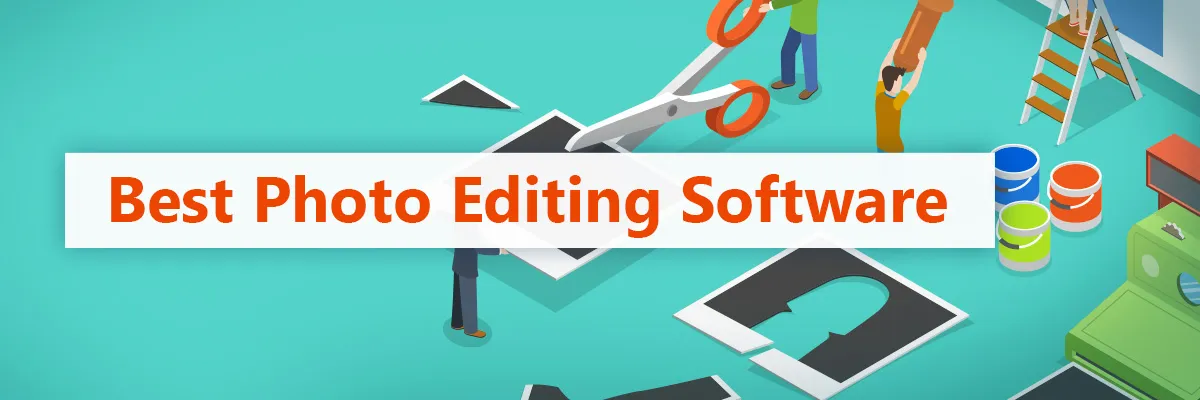
With Instagram and other photo-sharing platforms on the rise, the demand for high-quality photos has never been greater. It may seem like everyone is a pro photographer these days, but the truth is, anyone can create stunning images! With the best photo editing software for beginners, even simple photos can become works of art.
Choosing the right software can feel overwhelming, especially for beginners. That’s where we come in. We’ve reviewed the top photo editing programs based on price, features, and ease of use to help you find the perfect fit. Keep reading to discover our top picks!
- Snapshot of Our Top 3 Best Photo Editing Software for Beginners
- 7 Best Photo Editing Software for Beginners
- How to Choose the Best Photo Editing Software for Beginners
- How We Test the Best Photo Editing Software for Beginners
- Best Photo Editing Software for Beginners Comparison Chart
- What is the Best Photo Editing Software for Beginners?
- Best Photo Editing Software for Beginners FAQ
Snapshot of Our Top 3 Best Photo Editing Software for Beginners

1. PhotoDirector - Best Overall
PhotoDirector is the best photo editing software for beginners, with a sleek and inuitive interface and guided edits. It is a full photo editing workflow, with tools to organize, design, share, print, and edit photos. It is filled with automatic, one-click tools for beginners, but also has manual adjustments for those who need them. Detailed Review >

2. PaintShop Pro - Best for Learning Editing
PaintShop Pro from Corel is on our list of the best photo editing software for beginners thanks to tons of learning resources. It also lets you edit photos automatically with AI-powered features and Smart Selection tools. Detailed Review >

3. Luminar Neo - Best AI Enhancements
Luminar Neo is loved by beginners and photographers alike for its powerful AI enhancement tools. It’s one of the best photo editing software for beginners looking to produce pro-level results. Detailed Review >
7 Best Photo Editing Software for Beginners
1. PhotoDirector - Best Photo Editing Software for Beginners
Pros
- User-friendly interface makes it easy to find and use any tool
- Millions of design assets including royalty-free stock images
- Huge feature set including photo organization and generative AI
- Tons of one-click tools and effects
Cons
- Stock content is only available with a subscription
Key Features
- Animated effects such as Dispersion and Sparkle add a glitter effect to photos
- Automatic color effects like Color Replace and Color Splash
- AI Retouching tools for face, skin, and body
- AI Replace swaps out one object for another using a text prompt
Compatibility:Windows, Mac
Beginner-Friendly Tools: 5/5
Price: Free
*Premium subscription available for $3.75/month
PhotoDirector is a comprehensive photo editing and organization software that caters to beginners, hobbyists, and experts. It combines a user-friendly interface with powerful features, including AI tools, making it the best photo editing software for beginners.
Its intuitive design enables seamless navigation, while AI-powered organization features, such as facial recognition and Smart Collections, keep your content well-organized. The adjustment sidebar offers easy sliders for color correction, resizing, and image repair, along with advanced tools like Dehaze, Defringe, and Denoise. Users can also localize effects for precise edits.
PhotoDirector doubles as a graphic design tool, offering templates, text designs, stickers, and over 130 million stock images and music tracks. Advanced users can benefit from layer editing with 27 blending modes. Export options cater to social media and print-ready formats.
The software's standout feature is its suite of AI tools, including AI Image Creator, AI Scene Generator, AI Background Replacement, and AI Headshot creation. These tools enable quick fixes, background replacement, and professional headshot generation without the need for photoshoots.
Affordable and continually updated, PhotoDirector includes a robust free version. It empowers users to create, edit, and share content as creatively as they can imagine.
Try the best photo editing software for beginners for free today with the link below.
2. PaintShop Pro - Best for beginners who want to learn photo editing and graphic design
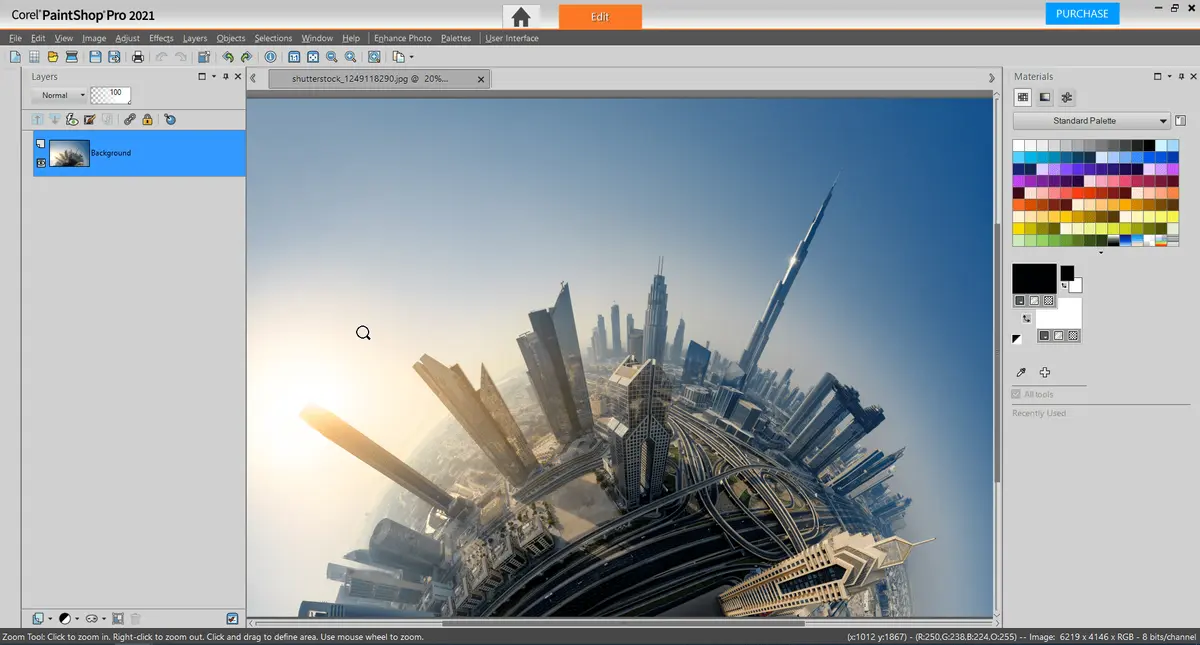
Pros
- Similar feature set to Photoshop, but much easier
- Affordable one-time fee
Cons
- Clunky workflow
- AI tools lag behind those found in competing software
Key Features
- Built-in templates for collages, greeting cards, social media images, and more
- RAW, HDR, and 360-degree photo editing
- Content-aware tools like SmartClone, Magic Move, and Magic Fill
Compatibility: Windows
Beginner-Friendly Tools: 5/5
Price: $79.99
PaintShop Pro is an affordable and user-friendly photo editing software ideal for beginners looking to explore photo management and editing. It offers advanced tools like 3D modeling, typography, layer editing, and photo organization, along with beginner resources like tutorial videos, a DiscoveryCenter, Learning Page, and User Guide.
It supports users of all skill levels with automatic features and manual options, such as the Selection tool for masking objects with Freehand, Magic Wand, Smart Selection Brush, Auto Selection, and Refine Brush. Time-saving tools like batch processing and Scripts further enhance productivity.
Often considered an easier, more affordable alternative to Photoshop, PaintShop Pro provides a comprehensive feature set. However, it ranks behind PhotoDirector due to less frequent updates (annually versus monthly) and less advanced AI tools. Additionally, PhotoDirector offers a more streamlined interface and workflow.
3. Luminar Neo - Best for AI image enhancements
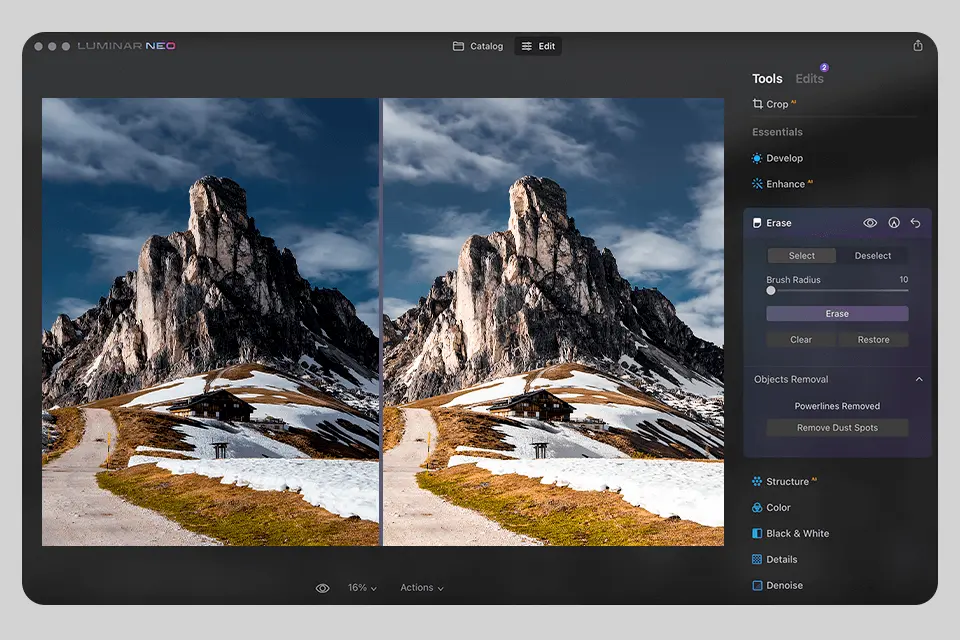
Pros
- A very user-friendly interface
- Continuously improved
Cons
- Some AI tools do not work as expected, such as the Noise Reduction tool
- Poor organizational features
Key Features
- Mask AI automatically selects architecture, water, sky, people, and more
- Generative AI tools like GenErase, GenExpand, and GenSwap
- Dodge and burn tools for lighting fixes
Compatibility: Windows, Mac
Beginner-Friendly Tools: 4.5/5
Price: $99/year for Explore and $119/year for Pro
Luminar Neo stands out for its extensive AI tools, each with an intuitive slider for adjusting enhancement strength. Tools like Enhance AI, Relight AI, Atmosphere AI, and Sky AI allow quick, accurate image improvements, including sky replacement with 35 options.
Its beginner-friendly interface simplifies editing with automated tasks and easy navigation across three modules: Catalog, Presets, and Edit. The Presets tab includes 120 filters, 50 image overlays, and 40 LUTs for creative customization.
While Luminar Neo excels in AI-powered enhancements and manual controls, its organizational features lag behind competitors, lacking keyword tagging and facial recognition. Additionally, its AI tools were occasionally inconsistent in tests. However, the program is highly responsive to user feedback, making it a solid choice for beginners seeking fast and impactful edits.
4. PhotoPad - Best for quick edits

Pros
- Supports RAW images and all popular image formats
- Includes digital asset management tools such as tags and ratings
Cons
- Outdated interface
- Can run slowly with large files
Key Features
- Automatically create an embroidery pattern or paint-by-number from your image
- Retouch tools including auto fix, noise reduction, and portrait touchups
- Selection tools for regional effects
Compatibility: Windows, Mac
Beginner-Friendly Tools: 4.5/5
Price: Free
*Premium versions available for $60 for Home and $70 for Pro
PhotoPad from NCH Software is ideal for beginners seeking quick and fuss-free photo editing. Its revamped interface offers easy access to basic tools like crop, rotate, resize, and flip, along with automatic adjustments and sliders for retouching, color correction, and effects.
Despite its simplicity, PhotoPad provides powerful features, including object removal, local effects, layer editing, HDR support, and graphic design tools for creating collages, calendars, cards, and more. It also boasts robust color effects like Color Boost and Color Dodge.
Frequent maintenance updates quietly add features, such as the new Remove Object tool. With a complete photo workflow, including digital asset management and strong sharing/printing capabilities, PhotoPad is a top choice for beginners, ranking above DxO PhotoLab for its ease of use.
5. Pixlr - Best for easy graphic design with templates
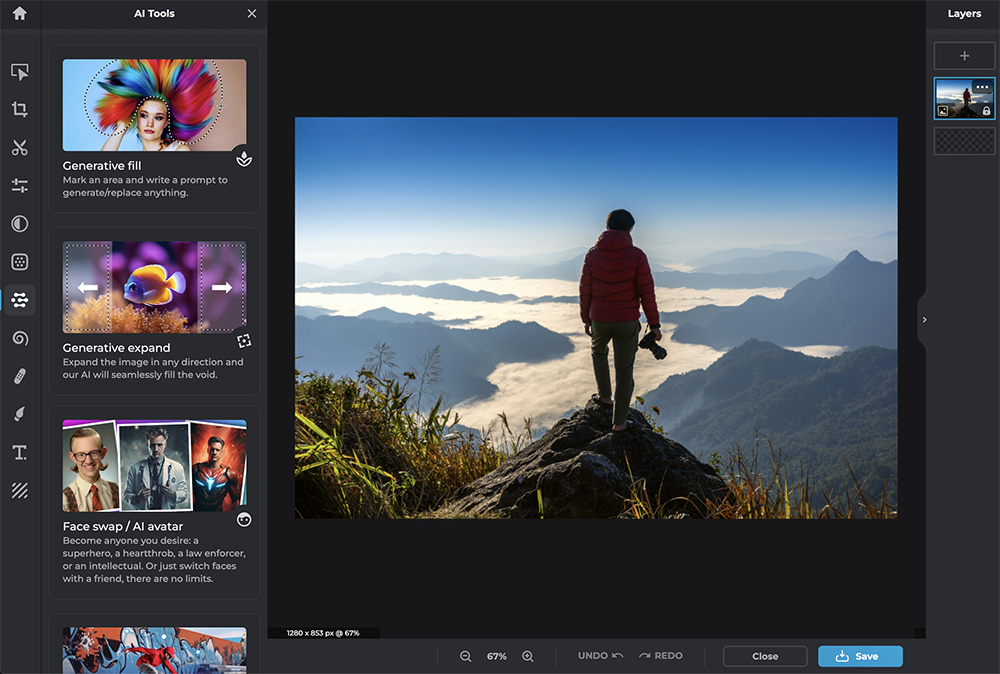
Pros
- Simplified layer editing
- Different interfaces for simple and advanced editing
Cons
- No organization tools
- Can be slow and glitchy, especially when uploading images
Key Features
- Color Picker, Color Replace, and Sponge Color for regional color effects
- Frame tool creates an automatic frame around a chosen area
- Dodge and Burn tools to lighten/darken areas
Compatibility: Windows, Web Browser
Beginner-Friendly Tools: 4.4/5
Price: Free
*Premium annual subscriptions are available for $.99/month for Plus, $4.90/month for Premium, and $9.91/month for Team
Pixlr is a versatile online photo editor also available for Windows PC, offering tailored interfaces for different tasks. It includes Pixlr Designer with 10,000+ templates, design elements, and animation effects; Pixlr Editor for advanced editing; Pixlr Express for one-click AI tools; a Background Removal Tool; and a Batch Photo Editor.
Quick Links provide access to popular features like an AI Image Generator, Generative Expand, and Generative Fill. Pixlr simplifies layer editing for beginners and offers customizable drawing tools and one-click effects such as Dispersion, Glitch, Liquify, and Mirror.
While frequently updated with trending features, Pixlr’s constant interface changes frustrate some users, and its generative AI tools lag behind competitors. Still, it remains a user-friendly option for both design and photo editing.
6. DXO PhotoLab - Best for noise reduction

Pros
- First-in-class lens corrections and noise reduction
- Excellent support for the newest cameras and lenses
Cons
- No support for HEIC/HEIF images
- Few photo workflow tools for printing or sharing
Key Features
- Innovative ColorWheel for easier color manipulation
- Nik U Point for accurate local adjustments
- Lens and camera-based autocorrection
Compatibility: Windows, Mac
Beginner-Friendly Tools: 4/5
Price: $139 for Essential, $229 for Elite
DxO PhotoLab is a top-tier photo editing software known for its standout DeepPrime noise reduction, which uses AI to enhance RAW photos during import, delivering results equivalent to two ISO stops. It’s ideal for professional photographers but also ranks among the best for beginners due to its effortless photo enhancements and organization tools.
Beginners benefit from its one-click fixes for common issues like noise, perspective, and color fade, making it easy to improve photos quickly. DxO frequently updates its Optics Modules to support the latest cameras and lenses, such as the Sony A9 III, and continues to add presets, LUTs, and ease-of-use improvements.
Although excellent for DSLR support, DxO PhotoLab lacks HEIC/HEIF compatibility, which may deter iPhone photographers. Additionally, it is not a full photo workflow solution, missing features like sharing, printing, and creating options. Despite these limitations, it’s a powerful choice for amateur photographers seeking high-quality RAW editing.
7. Lightroom - Best for lighting adjustments and night photography
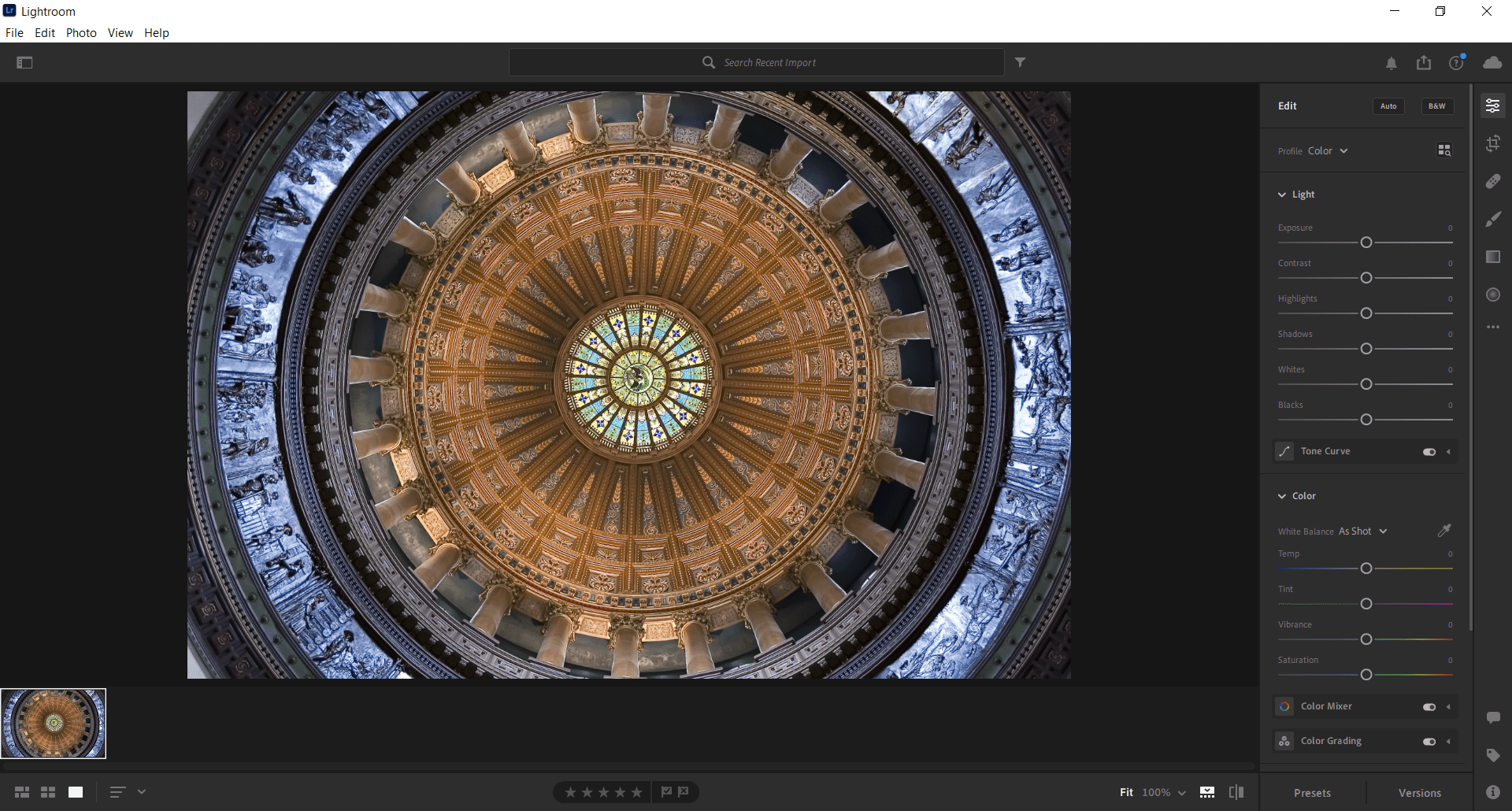
Pros
- Great image management/organization/cataloging tools
- Excellent preset library and lighting adjustments
Cons
- No layer editing tools
- No graphic design tools
Key Features
- Camera-based corrections
- Gradient and brush adjustments
- Streamlined photo management
Compatibility: Windows, Mac
Beginner-Friendly Tools: 4/5
Price: $9.99/month
Lightroom is a top choice for beginners needing image adjustments, offering intuitive sliders for exposure, contrast, highlights, and more. Its masking tools allow precise edits to individual colors or objects, and it excels at lighting adjustments, particularly for enhancing night shots while reducing noise.
With powerful healing tools and AI-powered presets, Lightroom stands out for its digital asset management and automatic tagging by facial recognition, date, keyword, GPS location, camera model, and more. Unlike Photoshop, Lightroom is beginner-friendly and includes helpful resources like Lightroom Academy, offering photography tutorials and a gallery for inspiration with “Before” and “After” images.
Though ideal for improving image quality, Lightroom lacks layer editing and graphic design tools, making it less suitable for those needs. Its high monthly fee may deter beginners, placing it at #7 on our list despite its excellent adjustment tools and ease of use.
Best Photo Editing Software for Beginners Comparison Chart
| Product | Best For | Notable Feature | Price | Download Link |
|---|---|---|---|---|
| PhotoDirector | Professional tools in a beginner-friendly package | Automatic image enhancements including AI upscaling tools, facial retouching, and object removal | Free; Premium: $3.75/month | Download |
| PaintShop Pro | Learning editing and graphic design | Content-aware tools like SmartClone, Magic Move, and Magic Fill | $79.99 | Download |
| Luminar Neo | AI image enhancements | Generative AI tools like GenErase, GenExpand, and GenSwap | Explore: $99/year Pro: $119/year | Download |
| PhotoPad | Quick edits | Selection tools for regional effects | Free; Home: $60 Pro: $70 | Download |
| Pixlr | Graphic design with templates | Local color effects and replacements | Free; Plus: $.99/month Premium: $4.90/month Team: $9.91/month | Download |
| DxO PhotoLab | Noise reduction | Lens and camera-based autocorrection | Essential: $139 Elite: $229 | Download |
| Lightroom | Lighting adjustments | Automatic keyword tagging of images for quick searches | $9.99/month | Download |
How to Choose the Best Photo Editing Software for Beginners
Choosing the best photo editing software for beginners depends on a few factors:
Ease of Use
Look for software with clear menus and tools that are easy to understand. Some software offer Guided Edits that help beginners learn how to edit photos with advanced tools. You’ll find most beginner-friendly software also have various AI-powered tools for accurate, one-click edits.
Features
Basic editing tools like cropping, exposure adjustment, and color correction are essential for users of any skill level. Otherwise, the best photo editing software for beginners depends on the user’s editing needs. If you plan to edit photos into YouTube thumbnails, flyers, ads, or posts for social media, then easy-to-use graphic design tools like templates, stickers, and filters are a must. If you are an amateur photographer and need photo management features, look for AI-powered tagging for automatic photo organization.
Budget
Free software is a great option for beginners. There are many powerful free photo editors available. Some are completely free, others offer a free trial of premium software, and some have a limited free trial. Paid software may offer more features and better performance, but it’s a good idea to test any software before downloading to make sure it’s a good fit.
How We Test the Best Photo Editing Software for Beginners
We test the best photo editing software for beginners using a variety of test photos with different lighting conditions, complexities, and resolutions. Here's a breakdown of what we look for during our tests:
User Experience
Is it easy to install? Does it require a powerful computer to run smoothly? Is the interface intuitive and user-friendly? Can you find the tools you need easily? How quickly does the software load and perform edits on different image sizes and formats?
Compatibility
Does it support the file formats you typically use (RAW, JPEG, PNG etc.)? Does it allow you to export your edits in various formats and sizes for different uses (web, print etc.)?
Editing Tools
We test the core editing tools like exposure, contrast, white balance, and saturation on all the best photo editing software for beginners to see how precise and intuitive they are. Next, we edit photos using selection tools to see if they are accurate and easy to handle.
If the software offers advanced features like layers, masks, or HDR editing, we test those as well to see if they work properly and are easy enough for new users to learn. We also check out any AI features like object recognition, automatic adjustments, and generative AI tools to check for accuracy.
What is the Best Photo Editing Software for Beginners?
Each of the best photo editing software for beginners offers a distinct set of benefits to users. While all of the options we presented are easy to use, some also offer advanced tools with guided edits that lower the learning curve for new users.
We think our top pick PhotoDirector will appeal to the widest range of users from any editing background or budget. The all-in-one platform offers a comprehensive array of tools, consistent updates, and incredible value. It has one-click tools and effects, manual adjustments, guided edits, layer editing options, and graphic design features. There are advanced tools for photographers, photo management features, and animated effects - all in a beginner-friendly package.
You can try PhotoDirector by downloading the free trial today with the link below.
Best Photo Editing Software for Beginners FAQ
The best photo editing software for beginners is PhotoDirector. It is clean and intuitive, with different interfaces for photo editing and organization/adjustments. There’s also a launch screen with links to PhotoDirector’s most trending tools. Most of PhotoDirector’s features are automatic, and there are Guided Edits for any features with 2 or more steps.
We recommend PhotoDirector for its basic photo editing features. You can edit photos quickly and easily with basic adjustments, one-click filters, automatic background removal, and tools like crop, rotate, and flip.
For those new to photo editing, it's advisable to start with fundamental techniques to enhance your images. Begin by mastering essential tools such as cropping, rotating, and applying preset filters. A user-friendly software like PhotoDirector can significantly streamline the editing process, as it employs advanced AI technology to help improve every detail of your images effortlessly. You can easily remove unwanted objects, deblur photos, and change backgrounds with professionalism, all without investing countless hours in the process.
For those embarking on their photography journey, selecting the right software is essential for maximizing image quality while minimizing editing time. We recommend PhotoDirector, which offers an array of AI-driven tools, intuitive adjustable sliders, and a variety of presets, making it an excellent choice for beginners looking to enhance their photos effortlessly.





